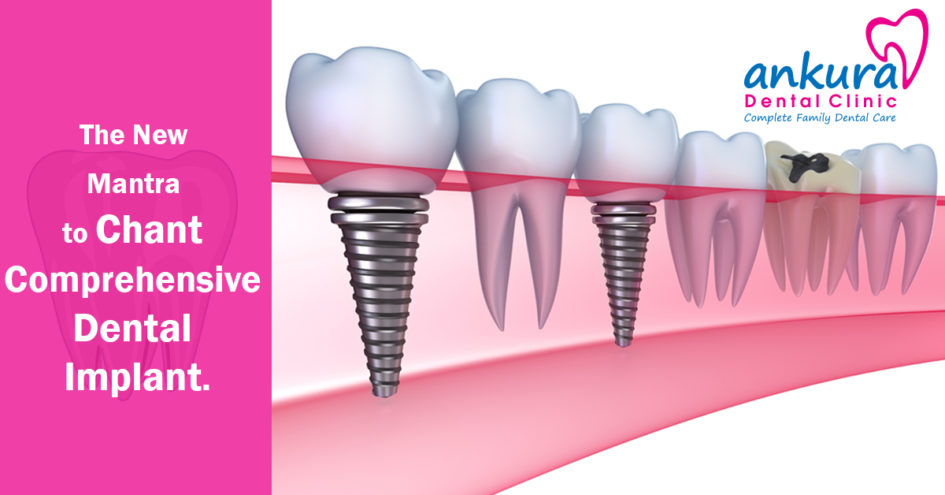Dentistry has evolved tremendously over the past few decades. Developed in the 1950’s, Implants are now the most prevalent and cutting edge technology that caters to various patient needs in the recent days.
In the recent past, Implants had been an expensive treatment plan for the patients from middle to lower socio economic status. But now it is done widespread by people from all fraternities and has become more affordable, one of the most privileged, preferred and comfortable treatment options in the restorative field of dentistry. The purpose of this article is to describe the advantages and limitations of dental implant and to evaluate the right candidate for implants.
Definition:
Dental Implants were invented in 1952 by Swedish Orthopedic Surgeon Per Ingvar Branemark. The Dental Implant is a surgical component that interfaces with the bone of the jaw or skull to support a dental prosthesis such as a crown, bridge, denture, facial prosthesis or to act as an Orthodontic Anchor.
Types of Implants
The American Dental Association considers 2 types of Implants to be safe. They are:
Endosteal Implants – These are Surgically implanted directly into the mandible / maxilla i.e. jaw bone. Once the Osseointegration happens ie the medical term denoting the fusion of implant to the surrounding bone, the second stage implant surgery is needed to connect the post to the original implant. Finally the artificial tooth ie crown or bridge is attached to the post individually or grouped on a bridge or denture.
Subperiosteal Implants – These consists of a metal frame that is fitted on the jaw bone just below the gum tissue. As the gums heal, the frame becomes fixed to the jawbone. Posts which are attached to the frame protrude through the gums. The crowns are then mounted to the posts.
At Ankura Dental Clinic, comprehensive Endosteal Implants are widely used.
Indications
The first and foremost indication for a dental implant would be in sites where there is an unavailability of posterior or last tooth to support a bridge or even if available the tooth does not have enough tooth structure or periodontal health to support a bridge.
The next indication is where there is a missing tooth even with teeth present posteriorly but implant supported crowns could be opted in preference to crowns and bridges as it avoids the unnecessary removal of tooth structure involved in crown and bridges especially in patients with tooth sensitivity issues thus preserving natural tooth structure wherever possible.
Implant Supported Overdentures – For patients who are completely lost all of their teeth i.e. completely edentulous and whose ridge is very much resorbed in such a way that dentures are becoming loose and not stable, Implant supported Overdentures are a boon. For such patients, the implants are fitted in the jaw bone,taking support of which the dentures can be fitted with help of posts. The dentures can be removed and cleaned easily as they are attached to the implants in a ball and socket fashion.
Orthodontic Mini Implants/Micro Screws
Implants are not only used to restore or replace missing teeth but also to some extent in straightening misaligned teeth. In the recent past, the Orthodontists had been widely using the back or posterior teeth for stability/support/anchoring units taking support of which the front teeth would be moved in front/back wherever desired, which was increasingly associated with a side effect called Anchorage Loss. This could be mostly avoided by means of using Orthodontic mini implants which serve as Temporary anchorage units fixed in the Jawbone Superficially, at the end of treatment the same are removed.
Investigations required for Implant Surgery
Conventional Panoramic Radiograph/OPG helps the clinician to assess basic information required like bone support below the teeth, the position and alignment of teeth and roots and the occlusion of teeth.
CBCT/3-Dimensional Computerised Imaging
The Conventional Panoramic Radiograph may not be able to furnish certain minute details that might be able required for the clinician to assess and perform the surgery especially bone density, proximity to blood vessels and sinuses. The CBCT Imaging enhances visualization of anatomical structures by revealing the anatomy 3-dimensionally which are reasonably not achievable through a normal X-ray.
Bone Densitometry Scans
If required and suggested by the dentist some patients especially elderly female patients have to undergo Bone density scans to assess bone density for implant placement and longevity.
Contraindications
→Patients with uncontrolled diabetes.
→Patients with surgical stents and pacemakers.
→Patients who have recently undergone radiotherapy/any other treatment for carcinomas.
→Very elderly patients who have crossed 78 years of age due to impaired healing capacity.
Precautions to be Taken
Patients who are have controlled diabetes and Hypertension can undergo implant surgery without fear provided they take their medication properly.
Patients who are taking blood thinner drugs like Aspirin and Clopidogrel have to discontinue medication 2 to 3 days before surgery.
Smoking patients have to discontinue the same to avoid unnecessary complications.
Any discomfort during surgery or treatment has to be informed to the treating dentist.
Conclusion
Man has adopted modern changes throughout evolution for making life simple and less cumbersome. Recent advances in Dentistry has undergone a paradigm shift from relying on the conventional cutting of tooth structure to preserving natural teeth wherever possible. Here in Ankura Dental Clinic we provide the best ever assessment and quality care to bring out the best possible outcome with Implant supported prosthesis.
Authored by :
Dr. TINTU B.D.S
Ankura Dental – Best Dental Clinic in Hyderabad
Tags: About Dental Implants, Best Dental Clinic Hyderabad, Bone Densitometry Scans, CBCT/3-Dimensional Computerised Imaging, Dental Endosteal Implants, Dental implant, Dental Implant Surgery, Dental Subperiosteal Implants, How much do dental implants cost?, Implant Supported Overdentures, Implant Surgery, Investigations required for Implant Surgery, Orthodontic Micro Screws, Orthodontic Mini Implants, Types of Dental Implants, What are Dental Implants





June 8, 2017 at 5:43 pm
Thank you for providing very useful and valuable information about dental implant.
June 8, 2017 at 5:43 pm
Very good information
June 9, 2017 at 6:20 am
Good information!!